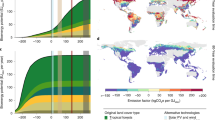Abstract
Smokeless (emission-free, clean, and efficient) biomass pyrolysis for biochar and biofuel production is a possible arsenal for global carbon capture and sequestration at gigatons of carbon (GtC) scales. The worlds annual unused waste biomass, such as crop stovers, is about 3.3 GtC y1. If this amount of biomass (3.3 GtC y1) is processed through the smokeless pyrolysis approach, it could produce biochar (1.65 GtC y1) and biofuels (with heating value equivalent to 3,250 million barrels of crude oil) to help control global warming and achieve energy independence from fossil fuel. By using 1.65 GtC y1 of biochar into soil and/or underground reservoirs alone, it would offset the 8.5 GtC y1 of fossil fuel CO2 emissions by 19%. The worldwide maximum capacity for storing biochar carbon into agricultural soils is estimated to be about 428 GtC. It may be also possible to provide a global carbon thermostat mechanism by creating biochar carbon energy storage reserves. This biomass-pyrolysis carbon-negative energy approach merits serious research and development worldwide to help provide clean energy and control climate change for a sustainable future of human civilization on Earth.
Access this chapter
Tax calculation will be finalised at checkout
Purchases are for personal use only
Similar content being viewed by others
References
Day DM, Lee JW (2004) The production and use of a soil amendment made by the combined production of hydrogen, sequestered carbon and utilizing off gases containing carbon dioxide. PCT Int Appl 58pp. WO 2004037747 A2
Lee JW Li R (1998) Method for reducing CO2, CO, NOx, and SOx emissions. ORNL Invention Disclosure. ERID 0631
Lee JW Li R (2002) Method for reducing CO2, CO, NOx, and SOx emissions. United States Patent No. US 6,447,437 B1
Day D, Evans RJ, Lee JW, Reicosky D (2005) Economical CO2, SOx, and NOx capture from fossil-fuel utilization with combined renewable hydrogen production and large-scale carbon sequestration. Energy 30(14):2558–2579
Lee JW, Hawkins B, Day DM, Reicosky DC (2010) Sustainability: the capacity of smokeless biomass pyrolysis for energy production, global carbon capture and sequestration. Energy Environ Sci 3(11):1695–1705
Denevan WM (1996) A bluff meddle of river in the settlement in prehistoric Amazonia. Ann Assoc Am Geogr 86(4):654–681
Woods WI, McCann JM (1999) The anthropogenic origin and persistence of Amazonian Dark Earth. Yearbook, conference of Latin Americanist geographer, vol 25, pp 7-14
Bard E (2001) Extending the calibrated radiocarbon record. Science 292:2443–2444
German LA (2003) Historical contingencies in the coevolution of environment and livelihood: contributions to the debate on Amazonian Black Earth. Geoderma 111:307–331
Gouveia SEM, Pessenda LCR et al (2002) Carbon isotopes in charcoal and soils in studies of paleovegetation and climate changes during the late Pleistocene and the Holocene in the southeast and center west regions of Brazil. Global Planet Change 33(1–2):95–106
Kuzyakov Y, Subbotina I, Chen H, Bogomolova I, Xu X (2009) Black carbon decomposition and incorporation into soil microbial biomass estimated by 14C labeling. Soil Biol Biochem 41:210–219
Steiner C (2006) Slash and char as alternative to slash and burn. Dissertation, University of Bayreuth, Germany
Okimori Y, Ogawa M, Takahashi F (2003) Potential of CO2 emission reductions by carbonizing biomass waste from industrial tree plantation in South Sumatra, Indonesia. Mitig Adapt Strat Glob Change 8:261–280
Shindell D, Faluvegi G (2009) Climate response to regional radiative forcing during the twentieth century. Nat Geosci 2:294–300
Kintisch E (2009) Climate change: new push focuses on quick ways to curb global warming. Science 324:323
Geider RJ, Delucia EH et al (2001) Primary productivity of planet earth: biological determinants and physical constraints in terrestrial and aquatic habitats. Glob Chang Biol 7(8):849–882
Sauerbeck DR (2001) CO2 emissions and C sequestration by agriculture—perspectives and limitations. Nutr Cycl Agroecosyst 60(1–3):253–266
Krausmann F, Erb K, Gingrich S, Lauk C, Haberl H (2008) Global patterns of socioeconomic biomass flows in the year 2000: a comprehensive assessment of supply, consumption and constraints. Ecol Econ 65:471–487
Gundale MJ, DeLuca TH (2007) Charcoal effects on soil solution chemistry and growth of Koeleria macrantha in the ponderosa pine/Douglas fir ecosystem. Biol Fertil Soils 43:303–311
Lehmann J, Gaunt J, Rondon M (2006) Bio-char sequestration in terrestrial ecosystems—a review. Mitig Adapt Strat Glob Change 11:403–427
Hamelinck CN, Faaij APC, den Uil H, Boerrigter H (2004) Production of FT transportation fuels from biomass; technical options, process analysis and optimisation, and development potential. Energy 29:1743–1771
Demirbas A (2007) Progress and recent trends in biofuels. Prog Energ Combust Sci 33:1–18
James OO, Mesubi AM, Ako TC, Maity S (2010) Increasing carbon utilization in Fischer–Tropsch synthesis using H2-deficient or CO2-rich syngas feeds. Fuel Process Technol 91: 136–144
Lee JW, Kidder M, Evans BR, Paik S, Buchanan AC, Garten C, Brown R (2010) Characterization of biochars produced from cornstover for soil amendment. Environ Sci Technol 44: 7970–7974
Rondon MA, Lehmann J, Ramírez J, Hurtado M (2007) Biological nitrogen fixation by common beans (Phaseolus vulgaris L.) increases with bio-char additions. Biol Fertil Soils 43:699–708
Rillig MC, Wagner M, Salem M, Antunes P, George C, Ramke HG, Titirici MM, Antonietti M (2010) Material derived from hydrothermal carbonization: effects on plant growth and arbuscular mycorrhiza. Appl Soil Ecol 45:238–242
Gundale MJ, DeLuca TH (2007) Charcoal effects on soil solution chemistry and growth of Koeleria macrantha in the ponderosa pine/Douglas fir ecosystem. Biol Fertil Soils 43: 303–311
Author information
Authors and Affiliations
Corresponding author
Editor information
Editors and Affiliations
Rights and permissions
Copyright information
© 2013 Springer Science+Business Media New York
About this chapter
Cite this chapter
Lee, J.W., Day, D.M. (2013). Smokeless Biomass Pyrolysis for Producing Biofuels and Biochar as a Possible Arsenal to Control Climate Change. In: Lee, J. (eds) Advanced Biofuels and Bioproducts. Springer, New York, NY. https://doi.org/10.1007/978-1-4614-3348-4_3
Download citation
DOI: https://doi.org/10.1007/978-1-4614-3348-4_3
Published:
Publisher Name: Springer, New York, NY
Print ISBN: 978-1-4614-3347-7
Online ISBN: 978-1-4614-3348-4
eBook Packages: Chemistry and Materials ScienceChemistry and Material Science (R0)




